Ancient Rome: Unveiling the Twelve Secrets Behind a Forgotten System
Ancient Rome, a civilization that flourished for over a millennium, has left an indelible mark on history, governance, and culture. Today, we delve into the enigmatic system that governed this mighty empire. Known as “The Twelve,” this forgotten system encompasses various aspects of Roman society, politics, and architecture, revealing mysteries and artifacts that continue to intrigue historians and archaeologists alike.
The Foundation of Ancient Rome’s Governance
The governance of Ancient Rome was complex and multifaceted, evolving from a monarchy to a republic and eventually to an empire. The Twelve Tables, established around 450 BC, were pivotal in shaping Roman law and governance. These laws provided the foundation of legal rights for all citizens, marking a significant step toward a more equitable society.
- Monarchy (753-509 BC): The early phase of Rome was ruled by kings, with a focus on familial lineage and power.
- Republic (509-27 BC): Transitioning to a republic, Rome developed a system of elected officials and representative governance.
- Empire (27 BC-476 AD): Under emperors, Rome saw the centralization of power and expansion across Europe, North Africa, and parts of Asia.
The Role of Society in Ancient Rome
Roman society was structured into distinct classes, each playing a crucial role in the functioning of the state. Understanding these classes is key to unlocking the secrets of Ancient Rome.
- Patricians: The elite class, wealthy landowners who held significant political power.
- Plebeians: The common citizens, including farmers, laborers, and merchants, who fought for their rights through the Conflict of the Orders.
- Slaves: Integral to the economy, slaves were considered property and had no legal rights.
Culture and Mysteries of Ancient Rome
The cultural landscape of Ancient Rome was rich and diverse, influenced by the various peoples and territories it encompassed. This cultural amalgamation resulted in numerous mysteries, from religious practices to architectural innovations.
Art and Literature
Roman art and literature reflect the values and beliefs of its society. Key figures include:
- Virgil: The author of the Aeneid, whose works became foundational texts of Roman literature.
- Ovid: A poet known for his transformative tales and exploration of love.
Architecture
The architecture of Ancient Rome is renowned for its grandeur and engineering prowess. Iconic structures include:
- The Colosseum: An amphitheater that showcased the might of Roman engineering and served as a venue for public spectacles.
- The Pantheon: A temple dedicated to the gods, notable for its massive dome and oculus.
Unearthing Artifacts: A Window into the Past
Archaeological discoveries have provided invaluable insights into Ancient Roman life. Artifacts such as pottery, coins, and inscriptions help historians piece together the daily lives of Romans.
- Pottery: Everyday items that reveal details about trade and domestic life.
- Coins: Used for commerce, they often featured emperors and were a means of propaganda.
Politics: The Machinery of Governance
Political life in Ancient Rome was characterized by power struggles, alliances, and conflicts. The Senate, composed of patricians, played a crucial role in governance, while popular assemblies allowed plebeians to voice their concerns.
Key Political Figures
Several figures stand out in the political landscape of Ancient Rome:
- Julius Caesar: A military general who expanded the Roman territory and played a pivotal role in the demise of the Republic.
- Augustus: The first emperor who established the Pax Romana, a period of peace and stability.
Step-by-Step Process of Governance in Ancient Rome
The governance of Ancient Rome can be broken down into a systematic process:
- Election of Officials: Citizens voted for their representatives in the Senate and popular assemblies.
- Legislation: Proposed laws were debated and voted upon, often influenced by political alliances.
- Implementation: Elected officials executed laws and governed their provinces.
- Judiciary: Courts were established to interpret laws and resolve disputes, ensuring justice was served.
Troubleshooting Tips for Understanding Ancient Rome
If you’re struggling to grasp the complexities of Ancient Roman governance and society, consider the following tips:
- Start with Timeline: Familiarize yourself with key events in Roman history to understand the evolution of governance.
- Study Primary Sources: Read works by Roman historians such as Livy and Tacitus for firsthand accounts.
- Visual Learning: Use maps and diagrams to visualize the political structure and territorial expansion.
Conclusion: The Enduring Legacy of Ancient Rome
Ancient Rome’s governance, society, and culture continue to captivate scholars and enthusiasts alike. By unraveling the secrets behind “The Twelve,” we gain a deeper understanding of the complexities that shaped one of history’s greatest civilizations. The artifacts and architectural wonders left behind are not just remnants of a bygone era but are vital links to our past, offering glimpses into the lives of those who once walked the streets of Rome.
For those interested in further exploring the mysteries of Ancient Rome, additional resources can be found at this external link. Additionally, for insights into modern interpretations of Roman governance, visit this internal link.
This article is in the category History and created by AncientSocieties Team
